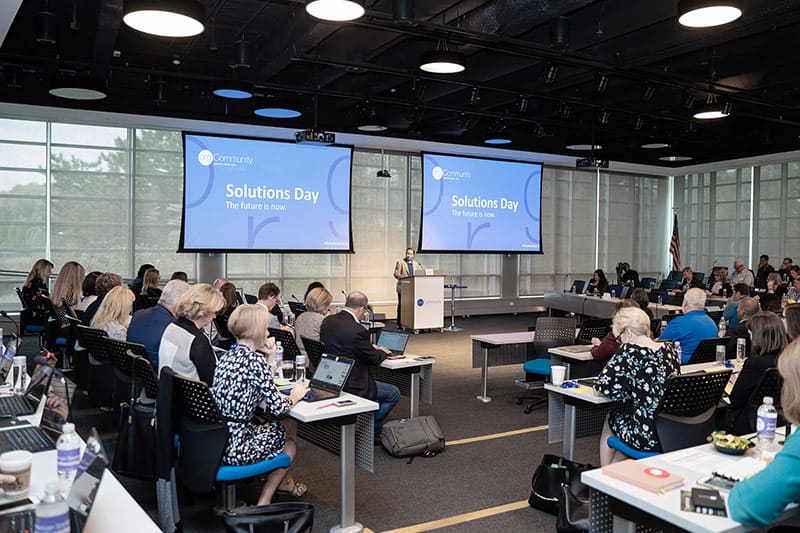
COVID made us lab rats in a variety of unusual experiments. Remote work was one of those unsettling tests. it was also an experience that transformed the employment landscape.
When Kevin Ordonez, my business partner, and I wrote our Association 4.0 books, a home office was still a glimmer in every busy parent’s eyes. Despite the novelty, we were interviewing some of the most forward-thinking leaders in our community. More than a few of those executives were managing virtual teams.
We sensed their frustration at the rest of the industry’s reluctance to welcome this new concept. Our colleague Stuart Meyer,* who at the time was CEO of the National Barbeque and Grilling Association, a fully virtual organization, made this comment.
“We must stop the punch-clock mentality and the belief that if we let staff out of our sight, they’re going to be doing anything other than working. It’s so easy these days to offer more flexibility through telecommuting and virtual workspaces. The traditional workplace reality is you’re lucky if you get up to five hours of productive work from each employee every day. Commuting, excessive meetings, disruptions and office politics erode productivity.”
Another executive, David Caruso, Co-Founder and President of HighRoad Solutions, told us this. “In 2005, when Highroad was one of the few virtual businesses, the concept raised some eyebrows. Today, the idea is more mainstream. Over time people have come to value the advantages of working at home. Businesses and even a few associations are moving away from bricks and mortar. There is no commute, and you have more time for family. I use the mornings to work out, and in the evening, instead of an hour on the road, I can spend the time watching my kids play sports.”
So, has our living laboratory brought us all onboard with the benefits of the virtual office? What are the lessons learned? One bit of wisdom is that like most skills, managing a remote team is both easier and more complicated than we could have imagined.
For every advantage, there is a trade-off. Even those people who vow to never set foot in an office again will admit the in-person world held some attractions. That being said, when you weigh PJs on the couch against adult clothing at a desk, cozy wins every time.
Following are a few of my observations on the indelible takeaways and lessons learned about remote work.
We Nailed It!
Maybe you aren’t ready to call your experience a win. Give yourself a break. I say it’s a victory. The circumstances were far from ideal. We were forced into situations that few were prepared to manage. Spouses, kids, roommates, and pets all shared a workspace. Moms and dads did a daily transition from mild-mannered parents into ninja educators. These circumstances added a layer of extraordinary complication. Most groups navigated the unusual challenges and got work done.

We produced virtual events–a first for many. We learned the importance of technology for communication and collaboration. Organizations that were reluctant to update systems corrected deficits. And, most importantly, we discovered new strategies for adaptation and problem solving. These skills can now be put to use under less urgent circumstances.
Lazy Communicators Got a Workout
Words either make or break online relationships. With limited access to body language, tone, and context, precise communication becomes an essential skill. Camera shy people learned that video is your best friend when you need to deliver an important message to a remote audience.
Virtual communication works better with boundaries and rules for engagement. A constant bombardment of messages in texts, via email, and on social platforms, causes burnout. Senders lose track of what they casually launched into cyberspace, and recipients struggle with the distracting chatter of too many digital voices. Groups that developed a structure and schedule for online meetings managed their time and effort more efficiently.
Learning to communicate with greater intentionality is another road to smooth virtual relationships. .orgSource Senior Consultant, Kevin Martlage, describes the process like this. “Intentional communicators bring a sense of responsibility and thoughtfulness to the conversation. Speakers are called on to deliberately choose words that accurately convey the meaning and the purpose of the interaction. While listeners are responsible for hearing what is said before formulating a response and asking follow-up questions that ensure they have correctly understood. Both participants must be aware of context, or unspoken emotional dynamics and backstory, that might influence the outcome.”
Understanding your co-workers’ preferred styles for interaction is another strategy that turns bumpy communications into superhighways. Team building programs can offer a window into individual work patterns and predilections. Now that the dust has settled, and everyone is more comfortable with online interactions, it’s a good time to invest in training.

The Myers Briggs Type Indicator is an excellent vehicle for delivering that insight. “The MBTI identifies how people prefer to receive, assimilate, and act on information,” Kevin advises. “It is also a fun and effective way to ease into conversations about communication, behavior, trust, and other interpersonal issues that are important to keeping culture on track.”
Culture Took Center Stage
During the pandemic, leaders quickly realized the importance of monitoring the temperature of emotions and behavior. Virtual work shines the high beams on culture. The idea that separation makes for more complex relationships is somewhat counterintuitive. But dysfunction need not be visible to be destructive.
We learned that having a history of shared values and expectations for behavior makes for healthier virtual environments. Kristine Hillmer, CEO at the Wisconsin Restaurant Association, offered this observation.
“We were in the office full-time pre-COVID, so we had a strong internal culture. Some of our employees have over 30-years tenure. Trusting relationships and a family atmosphere already existed. When we went virtual, losing those connections was difficult. We organized the usual Zoom happy hours. But we also paid special attention to looking after each other.
“To help our operators survive, people worked 15-hour days. We had to ensure that the team cared for themselves and that we were caring for them. Otherwise, we would not have been able to sustain that degree of support.
“The shared challenge bonded a lot of folks. ‘How are you doing? How can I help you? Do you have the resources you need?’ became part of our call to action.”
Consideration Counts
Kristine highlights a significant concept. Strong cultures promote empathy. In virtual situations, awareness of your colleagues’ perspectives and needs is critical. It’s easy for people to feel disconnected, or even isolated, when they are working from home. That extra minute it takes to offer words of encouragement, praise, or understanding goes a long way toward making the virtual office a more welcoming place.
Now that the crisis is over, there has been pushback from leaders about how much virtual time should be allowed. Some would prefer to see their teams back in the office much more frequently.
Adaptability is a hallmark of digital markets. I urge CEOs to be flexible on this issue. While it may not always feel comfortable to have a screen between you and your team, don’t allow issues of convenience, trust, or perceived complexity to prevent you from bringing your business into the future. With patience, those challenges are easy to overcome.
Your willingness to bend toward better work/life balance tips the scales in favor of culture. And, a strong culture serves the organization well no matter where people conduct its business.
*Stuart Meyer is currently Founder and Chief Storyteller, Social Frequency Media.


